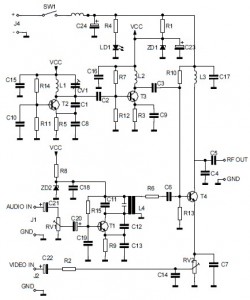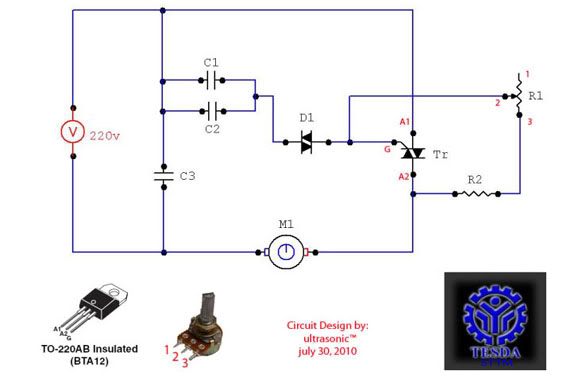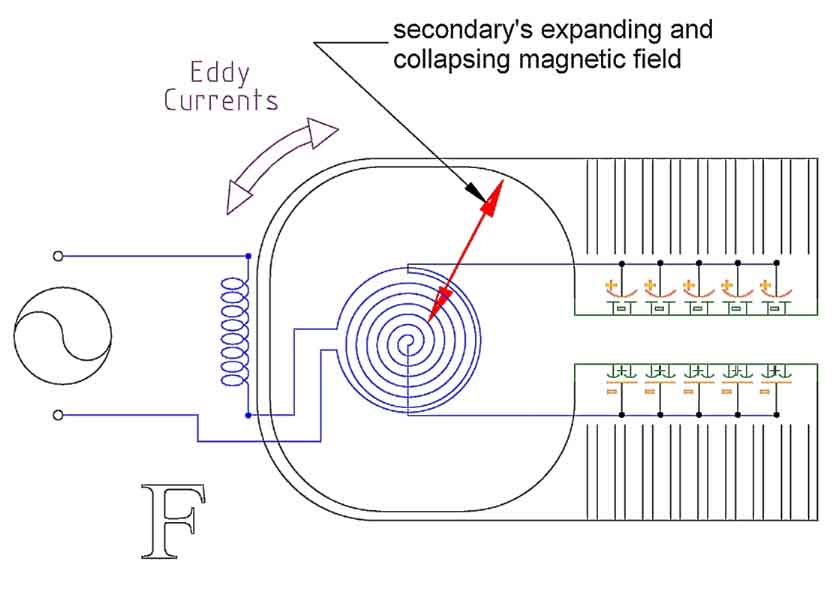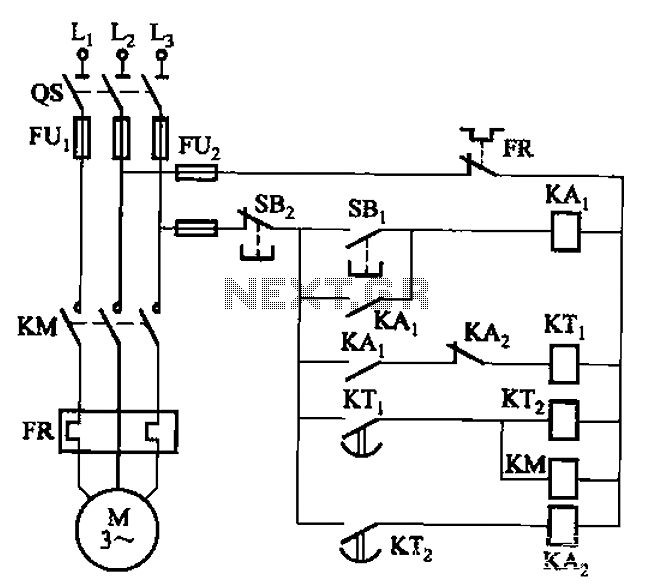
Simple Audio Filter Analyzer Circuit
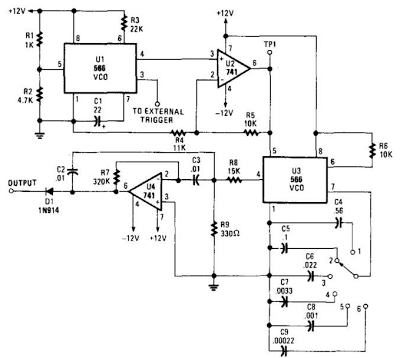
When this circuit is connected to a filter and an oscilloscope, the oscilloscope displays the filter's frequency response. A frequency that sweeps from low to high is applied to a filter. The oscilloscope is triggered by the start of the sweep and ends its trace at the highest frequency of the sweep. The filter output is connected to the vertical amplifier of the oscilloscope. Using bandpass filters as an example, as the bandpass frequency is approached, reached, and passed, the oscilloscope follows the peaking output and draws the response curve. The 566 VCO (U1) produces a VLF triangle wave to frequency modulate the next stage. It also produces a square wave to externally trigger the oscilloscope. Operational amplifier U2 (a 741 unit) optimizes the amplitude and the DC component. Another VCO (U3) generates the actual sweeping triangle wave, with its frequency selectable via switch S1. Operational amplifier U4 (another 741 op amp) is configured as a bandpass filter and serves as an example filter. Finally, diode D1 removes the bottom half of the output, resulting in a bell curve. To set up and operate the circuit, power up the circuit and oscilloscope. Set the oscilloscope's TIME/CM to 50 ms/cm and the VOLTS/CM control to 2 V. Attach a probe from the circuit's trigger to the oscilloscope's external trigger input, and configure the triggering mode to normal, external. Connect a probe from the vertical amplifier to test point TP1. A diagonal line will appear across the CRT. Input coupling should be set to DC. Adjust the triggering level until the diagonal line runs from the upper left to the lower right of the CRT, ensuring a displayed sweep from low to high. Finally, disconnect the probe from TP1 and attach it to the filter output past the diode.
The described circuit facilitates the visualization of a filter's frequency response using an oscilloscope. This setup employs a combination of voltage-controlled oscillators (VCOs) and operational amplifiers to generate and optimize the signals used for the frequency sweep. The primary component, the 566 VCO (U1), is responsible for producing a very low frequency (VLF) triangle wave that modulates the frequency of the subsequent stage. This triangle wave serves as a basis for the frequency sweep across the filter.
Operational amplifier U2, a 741 type, plays a crucial role in optimizing the output amplitude and ensuring the correct DC component is maintained. This optimization is essential for accurate frequency response analysis. The second VCO (U3) generates the sweeping triangle wave, with its frequency adjustable via switch S1, allowing for flexible testing across various frequency ranges.
Operational amplifier U4 is configured as a bandpass filter, demonstrating the filtering characteristics of the circuit. The inclusion of diode D1 is critical as it clips the lower half of the output signal, producing a bell-shaped curve that is easier to analyze on the oscilloscope.
To properly set up the oscilloscope for this analysis, specific configurations must be made. The TIME/CM setting determines the time scale of the displayed waveform, while the VOLTS/CM setting adjusts the vertical scale to ensure the signal is adequately displayed. The external trigger input facilitates synchronization with the start of the frequency sweep, allowing the oscilloscope to accurately capture the response curve.
During operation, the adjustment of the triggering level is vital to ensure that the displayed sweep accurately represents the low-to-high frequency transition. This careful calibration allows for a clear visualization of the filter's frequency response, showcasing how the output varies as the input frequency approaches, reaches, and surpasses the bandpass range. The final connection to the filter output past the diode allows for the observation of the filtered response on the oscilloscope, providing valuable insights into the circuit's performance characteristics.When this circuit is connected to a filter and an oscilloscope, the scope displays the filter`s frequency response. A frequency that sweeps from low to high is applied to a filter. An oscilloscope is triggered by* the start of the sweep and ends its trace at the highest frequency of the sweep.
The filter output goes to the vertical amplifier of th e oscilloscope. Using bandpass filters as an example, as the bandpass frequency is approached, reached, and passed, the scope follows the peaking output and draws the response curve. A neat effect! The 566 VCO (Ul) produces a VLF triangle wave to frequency modulate the next stage. It also produces a square wave to externally trigger the scope. Op amp U2 (a 741 unit) optimizes the amplitude and the dc component. Another VCO (U3) produces the actual sweeping triangle wave. Its frequency is selectable via SI. Op amp U4 (another 741 op amp) is set up as a bandpass filter and has been included as an example filter.
Finally, diode D1 chops off the bottom half of the output, and leaves a nice bell curve. lb set up and operate, power-up the circuit and scope. Set the scope`s TIME/CM to 50 ms/cm. Set the VOLTS/CM control to 2 V. Attach a probe from the circuit`s trigger to the scope`s external trigger input. Set the triggering mode to normal, external. Attach a probe from the vertical amplifier to TP1. You`ll see a diagonal line that runs across the CRT. Input coupling should be set to dc. Adjust the triggering level until the diagonal runs from the upper left to the lower right of the CRT to ensure a displayed sweep from low to high. Now, disconnect the probe from TP1 and attach it to the filter output past the diode. 🔗 External reference
The described circuit facilitates the visualization of a filter's frequency response using an oscilloscope. This setup employs a combination of voltage-controlled oscillators (VCOs) and operational amplifiers to generate and optimize the signals used for the frequency sweep. The primary component, the 566 VCO (U1), is responsible for producing a very low frequency (VLF) triangle wave that modulates the frequency of the subsequent stage. This triangle wave serves as a basis for the frequency sweep across the filter.
Operational amplifier U2, a 741 type, plays a crucial role in optimizing the output amplitude and ensuring the correct DC component is maintained. This optimization is essential for accurate frequency response analysis. The second VCO (U3) generates the sweeping triangle wave, with its frequency adjustable via switch S1, allowing for flexible testing across various frequency ranges.
Operational amplifier U4 is configured as a bandpass filter, demonstrating the filtering characteristics of the circuit. The inclusion of diode D1 is critical as it clips the lower half of the output signal, producing a bell-shaped curve that is easier to analyze on the oscilloscope.
To properly set up the oscilloscope for this analysis, specific configurations must be made. The TIME/CM setting determines the time scale of the displayed waveform, while the VOLTS/CM setting adjusts the vertical scale to ensure the signal is adequately displayed. The external trigger input facilitates synchronization with the start of the frequency sweep, allowing the oscilloscope to accurately capture the response curve.
During operation, the adjustment of the triggering level is vital to ensure that the displayed sweep accurately represents the low-to-high frequency transition. This careful calibration allows for a clear visualization of the filter's frequency response, showcasing how the output varies as the input frequency approaches, reaches, and surpasses the bandpass range. The final connection to the filter output past the diode allows for the observation of the filtered response on the oscilloscope, providing valuable insights into the circuit's performance characteristics.When this circuit is connected to a filter and an oscilloscope, the scope displays the filter`s frequency response. A frequency that sweeps from low to high is applied to a filter. An oscilloscope is triggered by* the start of the sweep and ends its trace at the highest frequency of the sweep.
The filter output goes to the vertical amplifier of th e oscilloscope. Using bandpass filters as an example, as the bandpass frequency is approached, reached, and passed, the scope follows the peaking output and draws the response curve. A neat effect! The 566 VCO (Ul) produces a VLF triangle wave to frequency modulate the next stage. It also produces a square wave to externally trigger the scope. Op amp U2 (a 741 unit) optimizes the amplitude and the dc component. Another VCO (U3) produces the actual sweeping triangle wave. Its frequency is selectable via SI. Op amp U4 (another 741 op amp) is set up as a bandpass filter and has been included as an example filter.
Finally, diode D1 chops off the bottom half of the output, and leaves a nice bell curve. lb set up and operate, power-up the circuit and scope. Set the scope`s TIME/CM to 50 ms/cm. Set the VOLTS/CM control to 2 V. Attach a probe from the circuit`s trigger to the scope`s external trigger input. Set the triggering mode to normal, external. Attach a probe from the vertical amplifier to TP1. You`ll see a diagonal line that runs across the CRT. Input coupling should be set to dc. Adjust the triggering level until the diagonal runs from the upper left to the lower right of the CRT to ensure a displayed sweep from low to high. Now, disconnect the probe from TP1 and attach it to the filter output past the diode. 🔗 External reference
